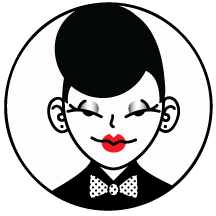Aja stands in front of greenery, wearing green. There is a green tie at her waist, and billowing sleeves. She holds her hand in prayer near her chin. Aja wears red lipstick and small daisies in her afro. She looks upwards.
Aja Barber is a writer, stylist and consultant focusing on the intersections of sustainability, fashion, and the textile industry. Her work explores the traditions of privilege, wealth inequality, racism, feminism, colonialism, and how these systems of power affect our buying habits.
Start with Your Own Style: a Conversation with Aja Barber on Sustainable Fashion
interviewed by addie tsai
I first came to know you on Twitter, and in the short time I’ve been aware of your work, I’ve already learned so much about not only fast fashion, but also the tensions and pushback you’ve gotten from others. Could you start by introducing yourself, and telling us a bit about how you got into this work?
AB: I’m a writer who deals in sustainability and all its intersections. I also constantly invite people to re evaluate the ways in which they consume.
What is fast fashion and why is it so harmful?
Fast fashion is clothing churned out rapidly (often in large quantities) with no consideration of the environment or the humans who make the clothes. It’s harmful because it takes a large environmental toll on the health of our planet while mistreating millions of people mostly in the global South. Because the churn of fast fashion is SO fast and constant, it means we the consumer are discarding and donating our clothes at a far higher rate than before. We've overloaded donation systems to the point where we are now dumping unwanted clothes on people in the global South who don’t need them or want them. The entire system is a mess.
For those who don’t have expendable income, what are some simple steps you suggest in quitting fast fashion and embracing ethical clothing habits?
Step 1: Always figure out your personal style. Fast fashion capitalizes on telling you what you should be wearing instead of you deciding for yourself. Figuring out what it is that you like means you make fewer mistakes when it comes to purchasing fewer clothes. But I tell people one way to lessen the impact of the system is to buy a couple of items second hand every year. I do this on sites like Vestiaire Collective and eBay. You don’t have to change your style just because you’re changing your ways. I look for brands I already know I love, which makes it so much easier plus you save money. I love nabbing a bargain on something I couldn’t afford a few years ago.
On the other hand, I’m assuming that just because a clothing item is expensive doesn’t make it sustainable. How does one ensure that who they’re buying from isn’t contributing to the problem?
I would say the question that cuts through all the BS is to ask the clothing brand if everyone who makes the clothes is paid fair wages. The high street dances around this question because there’s no way they can ensure this. But smaller brands can usually tell you exactly who made your clothes and in what conditions. Plus you get to buy some really unique items. Smaller brands are the way forward for buying new clothes.
Tell us more about how race and racism is a part of the problems you see in the fashion industry.
From start to finish the fashion industry is built off the labor of brown and Black people. From chattel slavery, which made it easier to produce clothing because of the quick production of cotton to British colonialism and the East India Company, which was all about disrupting the cotton trade which made India a super power. Additionally today raw materials are produced in non white countries in the global South. The labor to produce the clothing comes from non white countries in the global South. And when we are done with our clothing it gets dumped right back on non white countries in the global South.
Who are your favorite sustainable indie designers right now that you think people need to know more about? We’d love especially to hear about designers who offer clothes for bodies not typically designed for, such as fat and disabled folks.
I do a line with my Lora Gene which brings me a lot of joy.
Let’s talk SHEIN. Tell our readers what makes buying from them so harmful, and any other popular fast fashion brands our readers should consider divesting from.
A lot of fast fashion brands you see on the high street have the same bad practices you see with Shein. Low paid workers in abusive situations. It’s why so many brands can price clothing so incredibly low. The price of clothing is artificially suppressed because there’s a lot of exploitation that’s been happening for a long time. What makes Shein scarier is the churn. The clothing they produce is five times that of your H&M and your Zara’s which means their footprint is huge and their waste ... will be everyone’s problem. Additionally the company is very murky and evades accountability and when that happens that’s how you end up with lead clothes. It’s just a general mess. Avoid! Avoid kids!
In a perfect world, what’s the fashion world you envision? How would it need to change?
The fashion world I envision is one where small, ethical brands are praised above all and given equal footing on the mainstage. This way the bigger brands would feel challenged to rise to the occasion.
This is a queer magazine, so, if you’re willing to share, we’d love to know the BIG THREE on your chart: sun, moon, and rising.
Ohmigod, am I a bad queer if I don’t know? (Laughs nervously)

